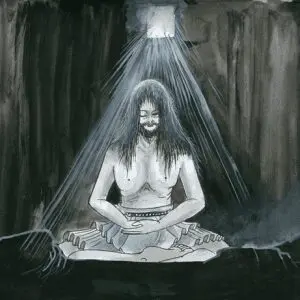
The Life Story of Khentrul Rinpoche Jamphel Lodrö
Khentrul Rinpoche is considered to be the third incarnation of the great Kalachakra adept Ngawang Chözin Gyatso. From his humble beginnings as a nomadic yak herder, Rinpoche’s life has exposed him to some truly extraordinary experiences. From his secret incarnation, through yak herding to his trip to the west, follow his timeline highlighting some of the key events which have helped shape the person he is today.
Special Note: Khentrul Rinpoche has had various visions from his personal deity instructing him to go by different birth dates at different times. The later dates on the timeline are correct but the birthdate we share of Rinpoche varies based on his instructions for his personal practice.
1967
Signs of a Coming Reincarnation

Before Rinpoche was born, his parents both received auspicious signs that a very special being would soon be born to the family. On one occasion, Rinpoche’s father went to visit a highly realized yogini named Tare Lhamo who was considered to be an emanation of the great Yeshe Tsogyal. Before he could reach the village, Tare Lhamo suddenly appeared before him. Rinpoche’s father prostrated and offered a blessing scarf to her. Accepting his pure offering, she bestowed upon him precious gifts such as medicine pills, protection cords and a letter rolled into a scroll.
When he arrived home he opened the letter to find that it contained various predictions. It stated that Rinpoche’s father would not live a very long life but would be reborn as a great tantric practitioner in northern Tibet. It also stated that Rinpoche’s mother was a great being who had experienced a hard life but had the seeds for many great beings to be born to her. However, the conditions were such that only one of those beings would become highly realized; with that occurring when he was in middle age.
On another occasion, Rinpoche’s mother had a vivid dream about her beloved master Getse Khentrul who had been imprisoned during the Cultural Revolution. In her dream, he wore a white-robe and was riding on a white horse as he approached her tent. She was surprised at his appearance since he had always worn the traditional maroon robes of a monk. He stopped at the threshold of her tent, tied up his horse and entered. She noticed that Getse Khentrul still had his monk robes with him, but carried them in his bag. He sat down on a white cushion and was presented a mandala offering by people she didn’t recognize. At the end of the ceremony, Rinpoche’s mother left the tent and noticed that the white horse was gone. When she awoke, she had the clear feeling that she would soon see her master again.
She would later learn from her husband that he had also had the exact same dream in which he and Getse Khentrul’s brother, Getse Varu, had made a mandala offering to the white clad teacher. Astonished by this amazing coincidence, the two mentioned the dream to their friends. When word reached Getse Varu, he confirmed that he had also had the same dream on the same night. These and other signs clearly marked the coming of a very special reincarnation.
1968
An Auspicious Birth
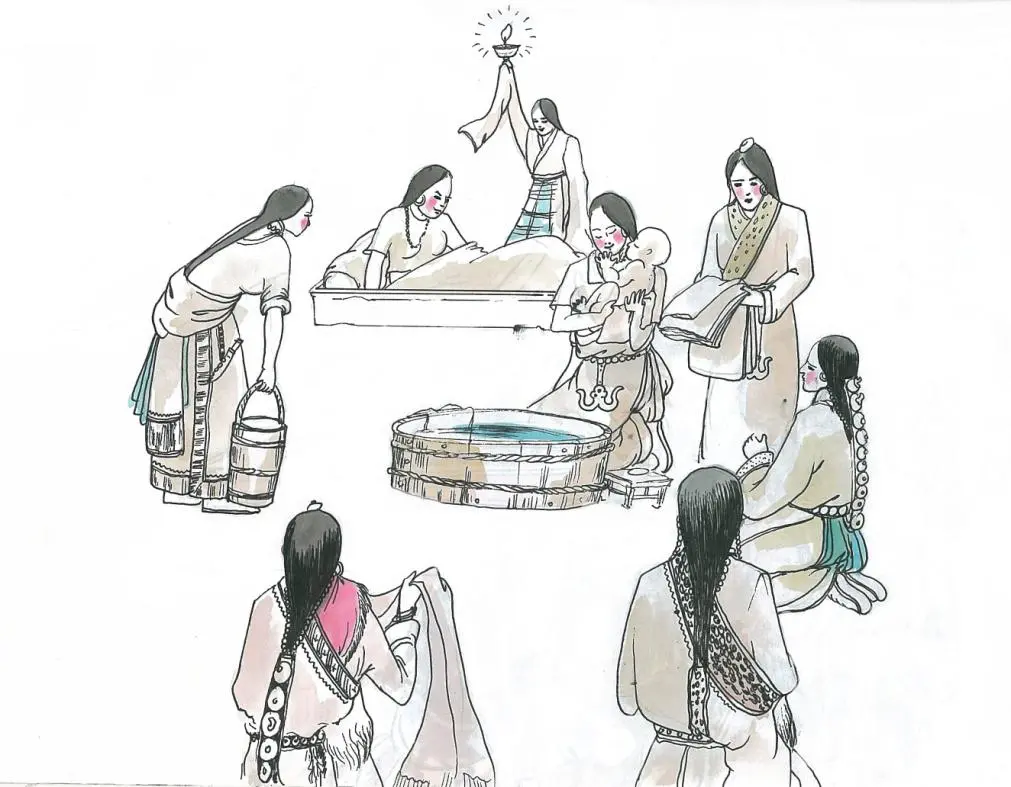
Rinpoche was born on the 18th of April, 1968 in the year of the Earth Monkey in Dera valley beside the Machu river. On the day he was born, villagers reported that the weather was unusually mild and lotus snowflakes fell gently from the sky. His mother’s waters did not break during her labour and he was born within a fully intact amniotic sac. This is a very rare occurrence that happens only once in every 80,000 births. The attendants were also surprised to see that his umbilical cord was not attached to the placenta. It is said that he did not cry like many newborn babies but instead smiled at his mother and her attendants. A number of children from the village said that they saw a rainbow appear over the family tent while his mother was in labour.
On the fourth day after Rinpoche’s birth a stranger arrived at their family tent. He was welcomed in the usual manner and invited inside. When he removed his long coat, everyone present saw that he was dressed in the traditional red robes of a monk. The stranger asked whether he could visit the mother and child in the birthing tent. Rinpoche’s father granted him permission but only because he was a monk. On entering the birthing tent, the monk bowed to Rinpoche’s mother and began to chant blessings. He then came closer and sprinkled blessed water on the baby’s body. After this he left as suddenly as he had arrived. Nobody had a chance to ask who he was or where he had come from.
A few days later, another visitor known as Kyangya made a dangerous journey across a frozen river to visit Rinpoche and offer his blessings. At that time, he told Rinpoche’s mother that he believed Getse Khentrul had indeed passed away and had now been reborn as her child. He performed a ceremony to protect the family and the baby and then recited the epic tale of Gesar of Ling in honour of the occasion.
1973
Secretly Recognised as Getse Khentrul

As a young child, Rinpoche continued to demonstrate unique traits. When he was only one year old, Rinpoche is said to have recited the mantra of Manjushri as his first words. After learning to walk he would make his way into open spaces where he recited mantras underneath the many prayer flags that fluttered in the wind. Once, when he was three years old, Rinpoche saw some mala beads on his mother’s altar and proclaimed “Heh! These are mine!” To which his mother responded, “Yes, but you gave them to me.” As though remembering, he said, “Oh, yes.”and placed the mala back on the altar.
When Rinpoche was five years old, his family visited a famous master in the region known as Gyarung Samdrup. Rinpoche’s mother spent time with this lama to overcome a sickness that she was experiencing. At that time, Gyarung Samdrup had a number of dreams regarding Getse Khentrul confirming Rinpoche to be his immediate reincarnation. He also made a number of predictions that Rinpoche would have a long life and in the future, he would become a great Dharma teacher, bringing incredible benefit to countless sentient beings.
During these early years, many of the lamas that Rinpoche’s parents had visited, warned them to keep Rinpoche’s status a secret. They had cautioned that if he had been publicly recognised as a reincarnated lama, he would experience great hardship and obstacles to his life. Following this advice, Rinpoche was raised as an ordinary child within the nomadic community.
1976
The Simple Life of a Yak Herder
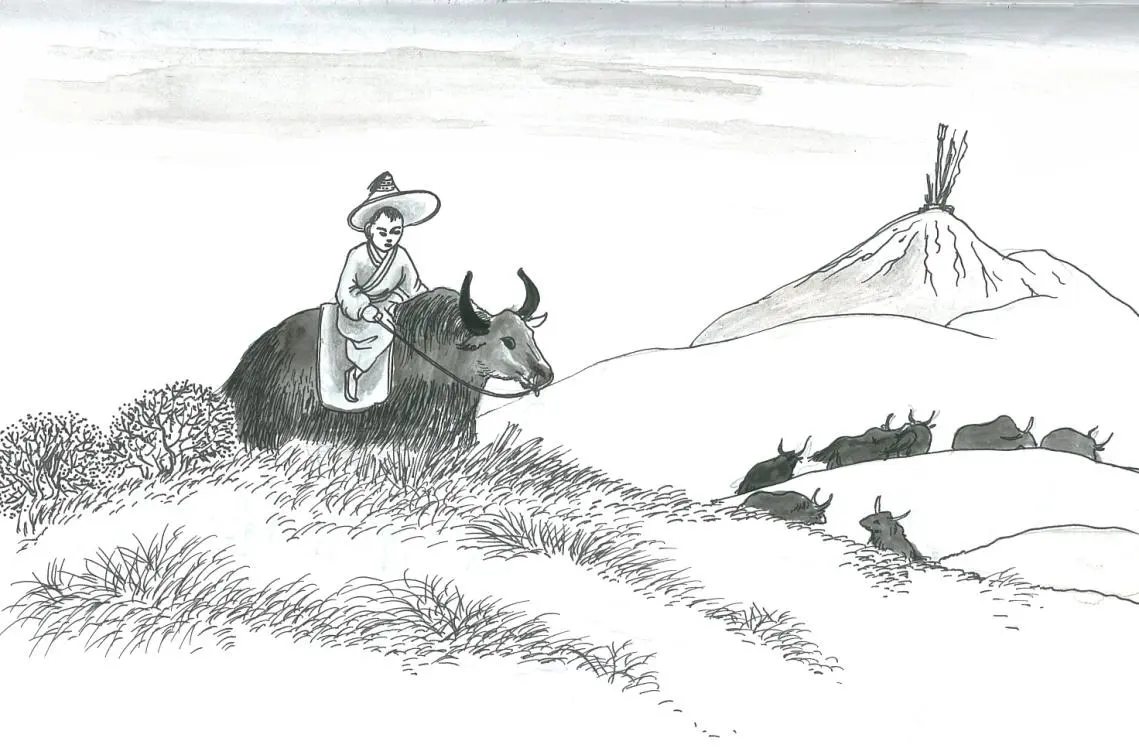
At the age of eight, Rinpoche was responsible for herding the family’s yaks. Accompanying his father, they would spend long days in the mountains watching over the animals. One day, a pack of wolves attacked the herd and killed eight of the yaks. With great devotion Rinpoche prayed to the manifestation of Tara known as Marichi and the wolves soon left. From that day forward, whenever he was herding the yaks, he would pray to Marichi by reciting her mantra. After that, taking care of the animals was easy and they were never under threat again.
One beautiful day, Rinpoche was herding the animals on the mountain. Fragrant flowers were abundant, the fresh grass green and lush, and a peaceful ambience pervaded the countryside. As he lay on the ground, the beauty of the place reminded him of the story of a famous Indian prince named Drimed Kunden. The prince was renowned for his generosity and compassion. Remembering his great charity and sacrifice, Rinpoche fell asleep.
While sleeping, he could hear beautiful music and woke suddenly. Gazing into the sky, he saw Prince Drimed Kunden with his wife and children dancing in the clouds. The prince was wearing a beautiful white flowing gown and had a perfectly formed topknot—just like an Indian prince. The princess had long, black, radiant hair and wore a finely woven silk dress encrusted with jewels draped with a finely embroidered shawl. Their two sons wore brightly coloured Indian silk garments. They all moved dreamily in the clouds, yet Rinpoche was experiencing this vision while wide awake. For the next few hours he entered a deep and clear state of meditation unlike anything he had experienced previously.
When Rinpoche was a little older, he began to study Buddhism with a monk who was staying with his family. During a teaching on Medicine Buddha, Rinpoche would often correct the monk on various mispronunciations he was making. He also demonstrated knowledge of many difficult subjects that he had not been taught in that life. Word quickly spread regarding Rinpoche’s natural familiarity with the Dharma.
1986
Father’s Death and Taking Ordination

After many years of prohibition, the Tibetans were eventually allowed to begin rebuilding their monasteries. Rinpoche’s father volunteered to help in the reconstruction of Denung Monastery and traveled a great distance to contribute what he could. Some time past and Rinpoche decided to join his father. When Rinpoche finally arrived, he found that his father was quite ill. His condition soon deteriorated and everyone feared that he would die. Soon after this, Rinpoche’s mother arrived saying that she had seen a number of inauspicious signs. Unfortunately, she was not allowed to stay with her husband due to regulations at the monastery.
One morning, Rinpoche’s father asked him to prepare a seat so that he could sit in a meditation posture. He was frail but could walk with assistance, so Rinpoche helped him to his seat, where he appeared to be comfortable. After a little while, his father said “Everything is white!” and gestured in front of him. He said it again, and then slumped forward slightly. Fifteen minutes later, Rinpoche realised his father had passed away when a monk entered the room and told him that he should just leave the body to rest quietly.
Prior to his father’s death, Rinpoche was uncertain about whether to become a monk. After his father’s death however, he felt that there was now no choice left for him. He felt that if he did not become a monk, his mother would die of a broken heart. With his father’s death as the catalyst, Rinpoche knelt down, bowed to his father’s body and promised to become a monk in order to fulfil his parents’ life-long wishes.
After completing the period of mourning for his father, Rinpoche received a number of auspicious signs in a dream that indicated it was time for him to become a monk. When he was seventeen, Rinpoche travelled to Denung Monastery and requested Lama Tulku Katag to bestow ordination on him. At that time, fifteen other monks were waiting for ordination. The Lama saw the timing of Rinpoche’s request as auspicious since it meant that sixteen monks would be ordained, matching the sixteen arhats who were the main disciples of the Buddha. The ceremony was given the following day.
Rinpoche and the other aspirants were ordained in small groups of only three monks at a time. During the ordination ceremony, as was the custom, each person drew a name from a hat. To Rinpoche’s surprise, he drew the name of Lama Tulku Katag’s teacher Amdo Geshe, who was also known as Jamphel Rolwi Lodrö. Tulku Katag informed Rinpoche that his ordination name would now be Jamphel Lodrö, a name that was both auspicious and precious.
1987
Learning How to Be a Monk
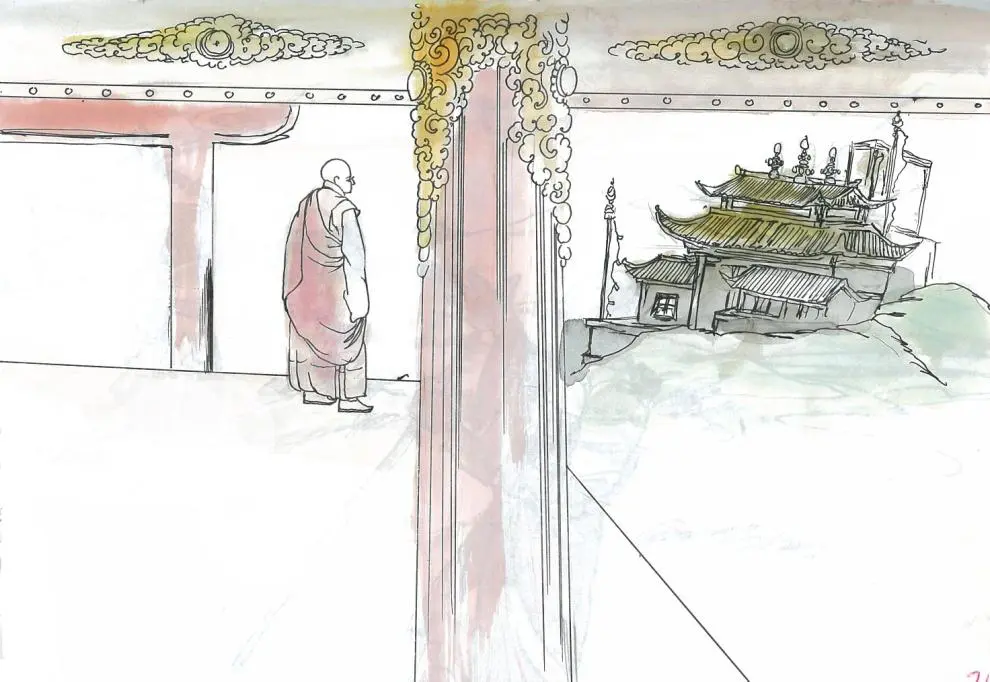
Eager to begin his training as a monk, Rinpoche approached his Vow Preceptor and requested teachings on the complete set of two hundred and forty vows that are presented in the Buddhist monastic discipline (Vinaya). Greatly pleased by Rinpoche’s pure intention, Tulku Katag proceeded to give Rinpoche and a handful of the monks four days of teachings on the vows. He praised Rinpoche for being so perceptive and said it was significant that he had asked for this teaching to be given, offering him a handwritten set of the thirty-six vows with additional commentary.
After returning home briefly to perform rituals for his recently deceased brother, Rinpoche traveled to Dhartang Monastery to continue his studies. Unlike the smaller monasteries that Rinpoche had done retreats in previously, Dhartang was a large monastic community with a few hundred monks staying there. In Dharthang, Rinpoche received teachings on Ngari Panchen’s book “Ascertaining the Three Vows” which presented a detailed commentary on the monastic vows and commitments as well as those of the Bodhisattva and Tantric vehicles.
Most of his days were spent in long sessions of chanting prayers. When teachings were given, they would usually consist of the teacher reading from a text with little explanation if any. The students would then be expected to memorize the texts during the evening. The following days they would be tested to see if they had integrated the material. Since Rinpoche had studied many of these materials with Lama Tulku Katag, he would often teach his roommates during the night.
Life in Dharthang proved to be quite challenging for Rinpoche. While most of the monks had taken ordination as children, Rinpoche had become a monk as a young adult. This fact, combined with Rinpoche’s natural proficiency in the Dharma soon generated tensions with some of his superiors who felt threatened by Rinpoche’s presence. While Rinpoche only wished to focus on his studies, he often found himself being dragged into the internal politics of the monastery.
1987
Dedicating Himself to Study

After taking some time to visit his younger brother in Kirti Monastery, Rinpoche returned to Dharthang for winter retreat. During that time, he engaged in the preliminary practices of the great Nyingma Tertön known as Lama Namchö Mingyur Dorje. This cycle was mainly propagated within the Palyul Tradition and was called “Buddhahood in the Palm of Your Hand”. It is used primarily as preparation for practicing Dzogchen, considered the highest teachings within the Nyingma School.
Feeling great devotion towards the treasure revealer Mingyur Dorje, Rinpoche made special effort to receive the complete transmission of the teachings and then dedicated himself day and night to completing the practices. This included rising early in the morning to complete a thousand prostrations before breakfast. Through great diligence he completed 100,000 prostrations over the span of just twenty-one days. Over the coming months, he would continue to meditate intensively on the remaining preliminaries of cultivating Bodhicitta, Vajrasattva purification, mandala offerings and guru yoga. After completing the preliminaries, he then meditated for one month on the syllable “A” in accordance with the tradition.
The following spring Rinpoche received many teachings from the very knowledgeable lama Khenpo Zhiten who had taken up temporary residence at Dharthang. Rinpoche was very inspired by the clear and structured way the Khenpo presented the Dharma. From that moment, he considered the Khenpo to be his teacher.
After many months of diligent study and practice, Rinpoche found himself filling in for a fellow monk who had been asked to recite teachings on Patrul Rinpoche’s “Words of My Perfect Teacher”. Even though he had only been ordained for a year, Rinpoche recited the complete text from memory without making a single mistake. This act earned him the respect of many of his peers in the monastery.
Rinpoche went on to train in the completion stage practices of working with the subtle channels and winds in order to control what is known as “inner fire” (tummo). Within the bitter cold of the Tibetan winter, they meditated outside with very little clothing to protect them. While most of the students could not endure the harsh conditions, Rinpoche and three other monks completed a one-month retreat. While this was not enough time to master the practice, it did help Rinpoche to build his resilience and strength of mind.
Over the coming years, Rinpoche received more teachings from Khenpo Zhiten. This included extensive teachings on the “Bodhisattva’s Way of Life” by Shantideva. Following his example, Rinpoche developed an overwhelming feeling of renunciation and faith in the teachings of Atisha and the great Kadampa Geshes. Based on this feeling, when the conditions arose, Rinpoche went on to receive full ordination from Khenpo Zhiten.
1990
Meeting His Root Guru
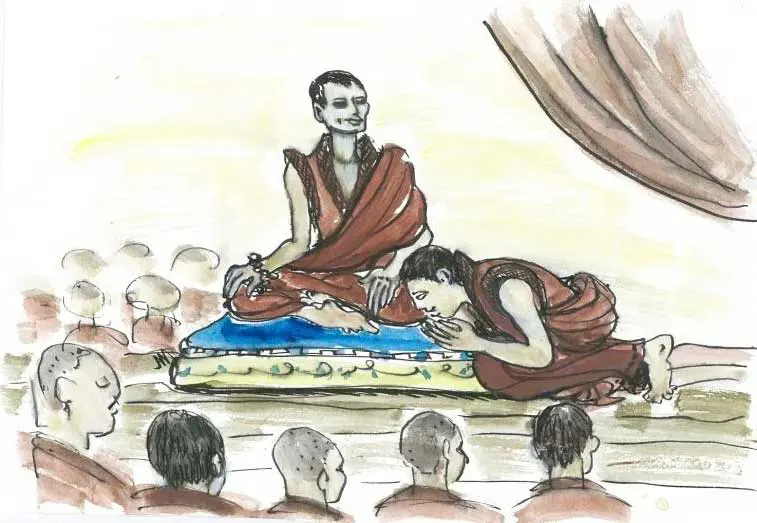
After many years of working with obstacles arising out of the internal politics of the monastery, Rinpoche made the decision that it was time to leave Dharthang. On the final night there, Rinpoche had a dream in which he encountered a huge, dark river with steep, overhanging cliffs. Making his way one step at a time, Rinpoche successfully crossed the river and climbed the massive rock walls. Having reached the other side, he saw a beautiful valley adorned with Buddhas, forests and streams with crystal clear water. There was a lady there wearing light blue robes riding a white horse. She pointed towards a beautiful cave, singing in a language that Rinpoche could not understand but nevertheless interpreted as, “Now all your difficulties and obstacles have come to an end. You must now do the Kalachakra practice there in that cave and while you are there I will protect you and so will many others like me.” Waking from his dream, Rinpoche had the strong determination to do a three year tantric retreat.
Setting out from the Dhartang, Rinpoche returned home before travelling to Jamda Monastery where one of his close teachers, Tulku Lobsang Norbu had been trained. There he spent a few months in retreat with the monks. Rested and filled with inspiration, he continued on his journey travelling to Se Monastery in Amdo Ngawa. It was there that Rinpoche expressed his desire to learn more about the Zhentong Philosophy of the Jonang Tradition. He asked the resident lama who he should request these teachings from and the lama pointed him to seek out the highly accomplished scholar-practitioner Jetsun Lama Lobsang Trinle. Upon hearing his name, Rinpoche was filled with great devotion. He was then directed to make his way to Chöthang Monastery where Lama Lutrin was getting ready to give teachings on Zhentong.
After many days of travel, Rinpoche eventually arrived at Chöthang Monastery on a day when the monks were taking a break from the teachings in order to celebrate. Eager to meet the Lama, Rinpoche made his way before the teacher, where he offered three prostrations. The unassuming Lama exuded the power of realisation and when he saw Rinpoche he motioned for him to come closer, even preparing a place for him using one of the cushions from his own seat. Feeling extremely humbled, Rinpoche sat with Lama Lutrin discussing the Dharma. At that time, Lama asked Rinpoche many questions about his practice and experience.
Following the teachings at Chöthang, Rinpoche accompanied Lama Lutrin to the famed Dzamthang Tsangwa Monastery where Lama Lutrin had been requested to teach on Zhentong by the Great Abbot Lama Yonten Zangpo. Dzamthang was home to over two thousand monks and was the main centre for the Jonang Tradition. It was here, at the request of Rinpoche, that Lama Lutrin refuted all criticisms of Zhentong Madhyamika presented in Thuken Lobsang Chokyi Nyima’s book “The Crystal Mirror of Philosophical Systems”. From this point forward, Rinpoche developed an unwavering faith in the Jonang teachings.
1991
Practicing in a Three Year Retreat
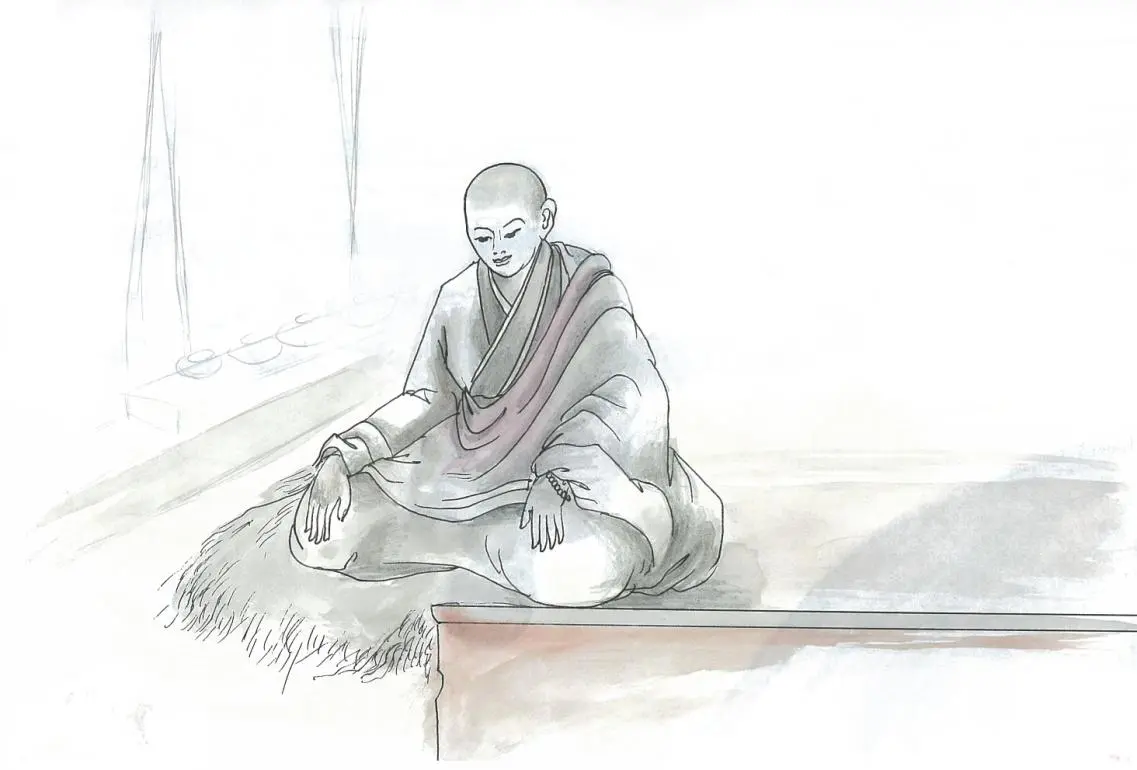
When Rinpoche was twenty-three he was fortunate enough to gather all of the conditions necessary to enter into a three-year retreat at Chöthang Monastery on the Kalachakra completion stage. As is customary in the Jonang Tradition, every monk is expected to do at least one three year retreat. At this time, eleven monks, most of whom were between the ages of nine and eighteen, would take part in the retreat. Rinpoche and one other monk were the only adult monks in the group. Recognising that the very young monks would struggle without help, Rinpoche took on the responsibility to tutor them throughout the retreat. Together, the monks engaged in the preliminary practices as presented in Jetsun Taranatha’s text “The Divine Ladder”. In parallel to these practices, Rinpoche also attended intensive study sessions with the scholarly monks.
During this period, Lama Lobsang Trinle gave an extremely potent Kalachakra Empowerment in which Rinpoche felt as though his entire experience was transformed into the Kalachakra mandala of 636 deities. It is customary during such ceremonies for the teacher to bestow each participant with a vajra name. To do this, Lama Lutrin requested Rinpoche to compose a list of names and then put those names into a hat. When it was Rinpoche turn, he drew the name Choyang Yeshi Dorje, meaning “Indestructible Primordial Wisdom”.
After completing the common and uncommon preliminaries, Rinpoche entered into the unique Kalachakra meditation practice known as the Three Isolations. This practice is conducted in a completely dark room where practitioners hold a specific yogic posture while meditating on the space-like nature of the mind. While Rinpoche struggled with the physical posture, through great perseverance he was eventually able to sit without pain for sessions of two to three hours.
When it came time to engage in the main practices of the Six Vajra Yogas, Lama Lutrin chose Rinpoche to be his teaching assistant. Lama Lutrin would teach for two hours, once every three to four weeks. During the rest of this time, it was Rinpoche’s responsibility to clarify the teachings for two of the meditation groups meditating at that time. In addition to an intensive meditation schedule, Rinpoche would often forgo breakfast in order to continue meditating or to participate in study sessions that were being held at that time.
At the age of 26, Rinpoche completed his retreat and the whole group went before Lama Lutrin to offer the merits of their practice. At that time, Rinpoche promised his Lama to spend at least nine months in intensive solitary retreat in a remote area. Lama Lutrin was very pleased by all of their efforts and blessed them to be successful in their practice. Following this, they held a great Tsok Feast to celebrate their accomplishments.
1994
Becoming a Rimé Master

Following the three-year retreat, Rinpoche began to wander from monastery to monastery, participating in a wide variety of teachings and retreats. With an unquenchable thirst for the Dharma, he did not limit himself to any single tradition but instead focused on learning many of the teachings from the major schools.
In order to improve the flexibility of his mind, he would often engage in debates with the local scholars of each monastery; taking the position of another tradition in order to challenge the monks to think beyond any narrow views they may have developed. For instance, when Rinpoche found himself in a Geluk monastery, he would often argue on behalf of the Nyingma tradition. Whereas when he found himself in a Nyingma monastery, he would often argue on behalf of the Geluk. He found that this process not only sharpened his own understanding of the Dharma but also helped dispel a large number of misconceptions that come from people only focusing on the faults of other traditions. Instead, he chose to emphasize the importance of recognizing the incredible value that each unique lineage offers.
It was during this period that Rinpoche visited the great monastery of Larung Chögar founded by the Rimé Master Khenpo Jigme Phuntsok. This massive monastery was home to a thriving community built on the principle of open exchange. At this monastery, there was no set curriculum that monks had to follow. Instead, scholars were free to participate in a variety of classes and debating sessions, drawing from all of the traditions. Rinpoche greatly enjoyed this open approach to the Dharma and it was in this environment that he thrived.
Not only did his time in Larung Gar help Rinpoche to integrate the ocean of teachings that he had received up to that point, but it also became clear to others that Rinpoche was a true Rimé Master. While Rinpoche was a little reluctant to accept this sort of acknowledgment, he eventually became more comfortable with the idea that he had grown into an accomplished scholar-practitioner.
In addition to a growing sense of confidence in his own capacity, Rinpoche’s devotion toward his omniscient master, Lama Lobsang Trinle also grew. By developing an extremely broad and vast view, he was able to see the amazingly profound nature of the teachings he had received from Lama Lutrin. A sense of overwhelming gratitude and appreciation arose within him for the immeasurable kindness that his lama had shown him.
1997
Publicly Recognized as
Ngawang Chözin Gyatso

After more than two years of visiting monasteries and supporting the people in his home village, Rinpoche finally returned to Chöthang to be with his Root Lama. At this time, Rinpoche began to learn more about the astrological systems of Tibet. Namely, the Naktsi system which emerged from China, and the Kartsi system which came from India. The latter was largely based on the very precise calculations found in the Kalachakra Tantra.
At this time, the entire monastery gathered for a tsok ritual. While everyone was chanting, Lama Lobsang Trinle entered the hall and asked the chanting master to stop. He then proceeded to give a short Dharma teaching regarding the importance of distinguishing authentic Dharma practice and authentic Dharma teachers. As part of this talk, he publicly praised Rinpoche by name for his many years of diligent study and practice and particularly for his non-sectarian approach.
From the time that restrictions were lifted on spiritual practice, Lama Lutrin bestowed the title of “Khenpo” to twelve of his students. On that day of the tsok feast he told the assembly that he wanted to give Rinpoche the title of “Rimé Choje”, which meant “Unbiased Dharma Lord.” He instructed that this was his formal title while in general contexts he could be referred to as Khenpo. He also proclaimed to more than four hundred monks in attendance, that Rinpoche was indeed the reincarnation of Getse Khentrul Jigme Jangchup Gyatso and that he should be honored as such. To mark the occasion, Lama Lutrin presented Rinpoche with a number of very special texts from his personal collection as well as his own ceremonial hat that he had worn during every teaching he had given. Receiving the title, the confirmation as a reincarnated lama, and this symbolic gesture from his master, Rinpoché was empowered as a lineage holder and spiritual heir to Lama Lobsang Trinle.
All of this was very surprising to Rinpoché who felt quite embarrassed to be suddenly thrust into the spotlight after living as a simple monk for so long. He had never discussed his family’s secrets with Lama Lutrin, so it was even more astonishing to find his Lama saying all of these things in public. Rinpoche would later learn that Lama Lobsang Trinle had privately conducted an investigation to know more about Rinpoche’s past lives since he was obviously a very special individual. To this end, he had gone to many high lamas and requested they identify who Rinpoche had been.
The high lamas confirmed that Rinpoche was the second incarnation of the great Kalachakra adept known as the Washul Lama, Ngawang Chözin Gyatso. This extraordinary practitioner was known for his phenomenal realizations and was a teacher to Lama Lutrin’s own root guru Ngawang Tenpa Rabgye and other great masters such as Bamda Thubten Gelek Gyatso. It was Ngawang Chözin Gyatso who then reincarnated as Getse Khentrul, who was subsequently born as Khentrul Rinpoche Jamphel Lodrö.
1997
Meditating in the Wilderness
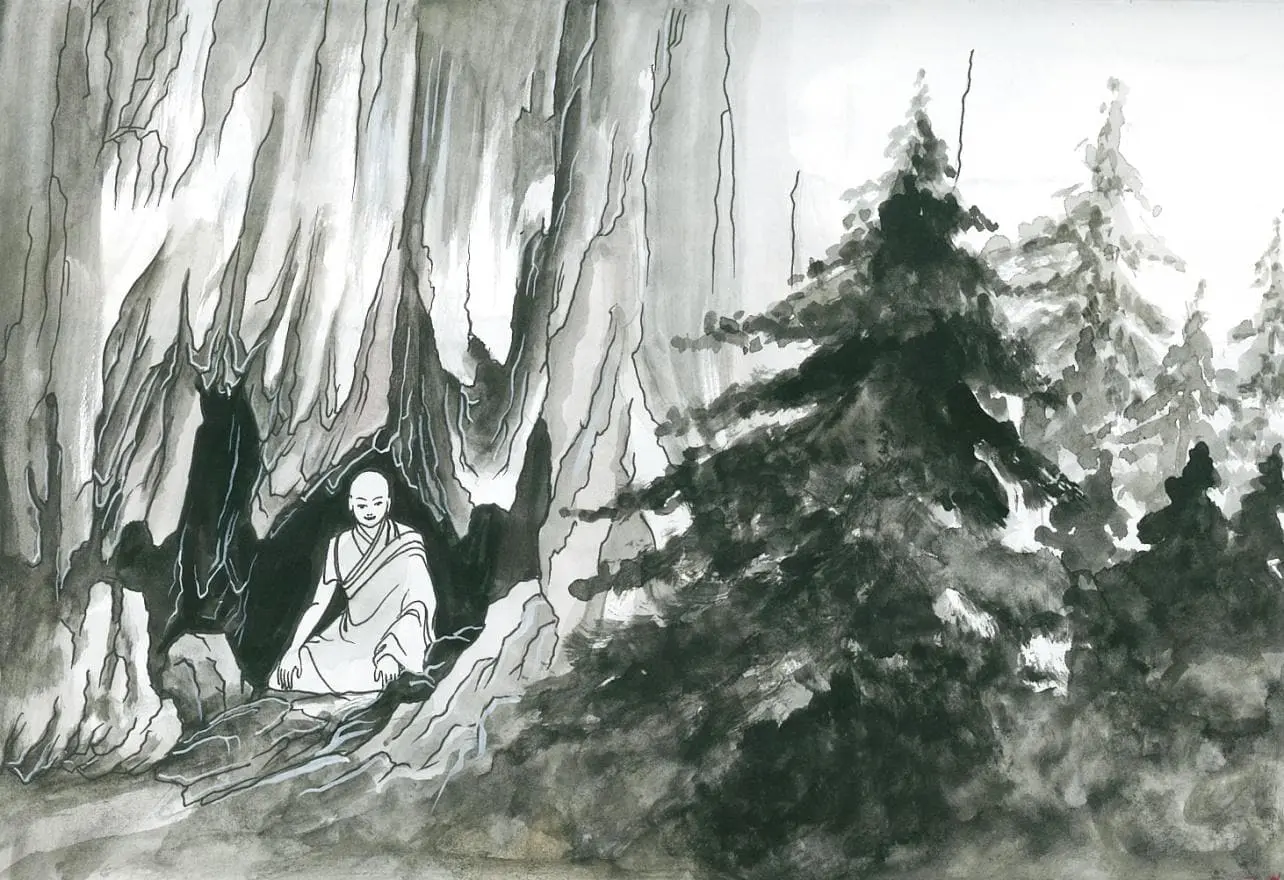
Later that year, Rinpoche went to visit one of Lama Lutrin’s most accomplished students, Kyangnak Kontsul who was in a life-long meditation retreat. When the two met, Kyangnak told Rinpoche that he had experienced a very auspicious dream the night before his arrival and then the two proceeded to have a very long and intense discussion about the Dharma that lasted well into the early hours of the morning.
Feeling extremely inspired by his visit with this most special of yogis, Rinpoche traveled to Dzamthang Tsangwa Monastery to spend time with some friends. While there, he was invited by the abbot of Dzamthang, Lama Yonten Zangpo to come to his room. Presenting Rinpoche with a ceremonial scarf and several gifts, Yonten Zangpo told Rinpoche that he was to stay in Dzamthang and teach the monks. While Rinpoche had no desire to teach, he accepted the position out of respect for Lama Yonten Zangpo who had bestowed on him the Kalachakra Empowerments.
With the blessing of Lama Lutrin, Rinpoche began teaching in Dzamthang, but quickly discovered that the situation was not going to work. Being in a position of leadership in such a large monastery meant that there was a great degree of politics involved. It became clear, that if Rinpoche wanted to maintain the purity of his practice, he would need to leave. So with a sincere letter of apology, he renounced his position and chose to follow in the footsteps of yogis like Kyangnak Kontsul and enter into solitary retreat in the wilderness of Tibet.
Taking only a rolled-up mattress, some blankets, and the most essential of belongings, Rinpoche traveled to the forest of Doi Arinak where great masters such as Patrul Rinpoche had meditated. Begging for food in the local villages, Rinpoche gathered enough supplies to last for seven weeks. He then went into the forest and found a clearing where he made his camp. Filled with contentment and serenity, Rinpoche dedicated himself to meditation.
At the end of the seventh week, as Rinpoche’s supplies were running out, he received a visit from two children dressed in strange clothing. He had not seen a single human being in all the time he had been there so was quite surprised to see these children come out of nowhere. After welcoming them, Rinpoche told them that he was planning on leaving soon to go get more supplies for his retreat. The two children warned him against this and told him that he should instead return home to see his family. They repeated this many times and eventually Rinpoche agreed and then they walked away.
A few days later, after further consideration, Rinpoche chose to heed the advice of the two children and to return home. On the way, he stopped in a forest to spend the night. After falling asleep, Rinpoche dreamt of the same boy and girl who identified themselves as Damchen and Ekajati, two Dharma Protectors often associated with the Dzogchen teachings. The two explained to him that he did not need to continue his forest retreat and that instead, he needed to apply his spiritual experience to wherever he found himself. Waking from his dream, Rinpoche was determined to take his life in a new direction.
1999
Travelling to the West

Upon arriving back in his village, it didn’t take long for the community to start requesting Rinpoche to perform many tantric rituals for their benefit. After two weeks of rituals, Rinpoche began to feel a strong desire to see his Lama. He could feel that something important was happening and so decided to set out for Chöthang Monastery immediately. When he arrived he found the monks performing a puja for Lama Lobsang Trinle. In public, Rinpoche was told that Lama was fine, but then in private, he discovered that Lama had passed into nirvana just a few days earlier. This fact was being kept secret in order to give Lama the privacy he needed to perform his meditation on death which lasted for five days.
The death of his precious teacher left a deep impact on Rinpoche. Even though Lama had warned his students that he would die that year, the sense of loss that he felt at that time was indescribable. After participating in all of the extensive pujas and practices that accompany the passing of a great lama, Rinpoche made a solemn vow to give up all worldly concerns for seven years. During that period, he would not visit his beloved family, nor involve himself in the matters of his home region.
In order to fulfill his promise, Rinpoche knew that he would need to create some distance from the world that he had known up to this point. It was then that the idea arose in his mind to travel outside of Tibet. He developed the aspiration to visit foreign lands, going beyond what was familiar and exploring what was possible.
Due to the ripening of this aspiration, Rinpoche was eventually able to gather all of the causes and conditions to be able to relocate himself to Melbourne, Australia. When he arrived, he enrolled himself in an English class to help him learn to communicate. While this world was drastically different from what he had grown up with, he was always determined and never gave up. For the next few years, Rinpoche would stay in a number of places around the city as he worked to develop his language skills and build connections within the local Buddhist community.
2005
Beginning to Teach Westerners
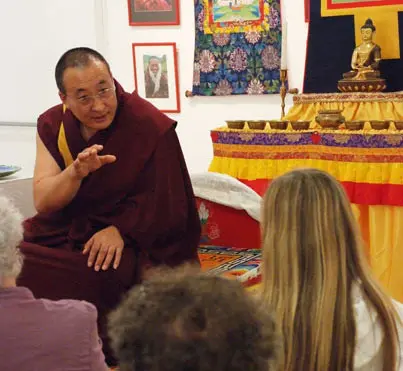
By the start of 2005, Rinpoche received word that his mother had fallen ill and was in need of an operation. Wishing to help her, he sent out a request within the Buddhist community for donations to pay for her operation. As a result of this request, Rinpoche met Julie O’Donnell who would go on to become one of Rinpoche’s closest Western students.
Julie invited Rinpoche to give teachings from her home in Upwey (an eastern suburb of Melbourne). Once a week, they would host teachings in her home and then on the weekend he would travel to different places in the city to give public Dharma talks. Even though his English was still quite limited, he used these events to improve his communication skills and to help lay the foundations of a Dharma community.
As a result of their efforts, under the guidance of Rinpoche, Julie established the Tibetan Buddhist Rimé Institute as a not-for-profit organisation that would support the realisation of Rinpoche’s projects. Around this time, they moved into a new home in the nearby suburb of Rowville that would allow them to expand their activities.
From the Rowville house, Rinpoche continued to give weekly teachings on the fundamentals of Tibetan Buddhism and also began to offer practice retreats for a growing number of students. At the same time, he became very active within the community offering many public talks on the subjects of happiness and meditation. He would also perform blessing ceremonies and funeral rites for those who requested them.
During this period, Rinpoche worked with Julie and other volunteers to compile his life stories and collect his teachings. From this material, they produced the first edition of his autobiography entitled “A Secret Incarnation” and new polished version of his rimé book called “The Path of Pure Vision”.
2006
Returning to Tibet
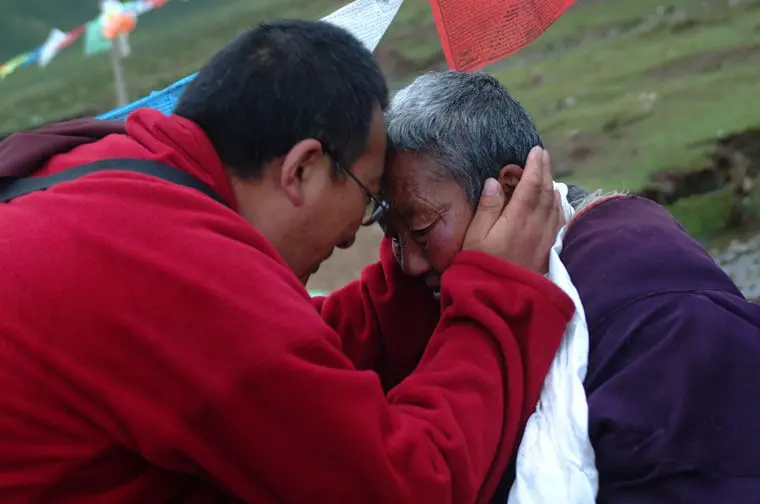
Seven years after Rinpoche had made his promise to his precious guru, Lama Lobsang Trinle; Rinpoche had finally created the conditions to return to Tibet and re-connect with his family. Due to the kindness of the donations that Rinpoche had received from his Western students, he had raised enough money not only to pay for his mother’s operation, but also to travel to Tibet to see her in person.
Accompanied by a small group of Western students, Rinpoche packed many suitcases worth of gifts and supplies for his ageing mother, his relatives and the people of his village. As they travelled towards Golok, they were greeted by throngs of monks who had come from all over the land to welcome him home and offer him white scarves. In the middle of a mountain clearing, they had set up a tent filled with food. Together, Rinpoche enjoyed a great feast with friends he had not seen since he left Tibet.
Continuing on his journey home, the roads came to an end and Rinpoche’s party were forced to transfer all of their luggage and supplies onto forty yaks arranged in a great caravan. Rinpoche was given a white horse decorated in flags, which he rode at the head of the long procession. Slowly, they made their way through the mountainous passes and beautiful summer valleys of Rinpoche’s childhood home.
As they approached their destination, everyone in the village and the surrounding region had come out to greet Rinpoche. They stood in a long line leading back to his home. Each person held an offering scarf and cheered as Rinpoche rode past. The sound of Tibetan horns and drums could be heard echoing through the mountains, heralding Rinpoche’s arrival.
When he finally approached his mother’s house, Rinpoche was filled with joy and immediately went to his mother, touching his head to hers as is the custom in Tibet. The two remained in this way for many minutes, as if they never wanted to part again. With tears welling up in their eyes, they eventually went inside to talk and to celebrate his return. This beautiful reunion would prove to be the last time that Rinpoche would see his mother alive as she passed away the following year.
Following his time with his mother, Rinpoche and his western students set out for Chöthang Monastery, visiting various monasteries on the way, including Jamda Monastery and Dzamthang Tsangwa. Similar to his reception in Golok, hundreds of monks lined the streets to welcome Rinpoche and honour him.
Since that time, Rinpoche has lead more than six tours to Eastern Tibet. Not only do these trips allow him to introduce his western students to the rich spiritual heritage that still flourishes in the region, but they also help him to maintain strong connections with the many great practitioners who live there. Through these connections, Rinpoche hopes to bring the blessings of the lineage into the world.
2007
Founding Tong Zuk Dechen Ling
(Rime Institute)
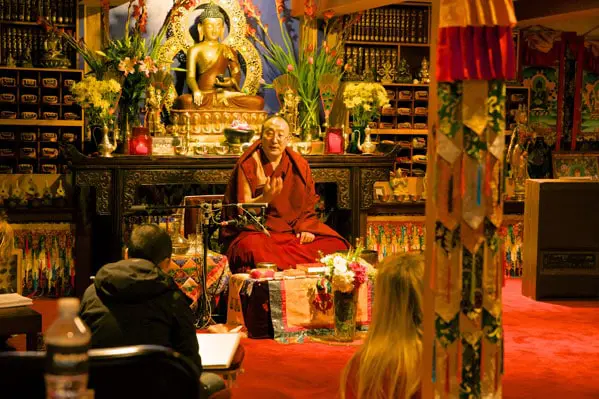
Upon returning to Australia, it became clear to Rinpoche that in order to help his fledgling community continue to grow, the Rimé Institute needed a permanent location that they could call home. For this purpose, he began to look for a property that could function as the basis for a future Dharma Centre. After an exhaustive search, he eventually found a beautiful house located in the small town of Belgrave, nestled in the vibrant forests of the Dandenong Ranges to the east of Melbourne.
After moving in, Rinpoche set to work with a team of volunteers to renovate the house and build a temple where students could receive teachings and practice meditation. While Rinpoche continued to lead weekly classes and retreats in the upper part of the house, the basement was slowly transformed into a beautiful space for spiritual practice that was filled with extraordinary blessings. When the construction process was complete, Rinpoché celebrated their achievement by giving the centre the name Tong Zuk Dechen Ling which means “Place of Empty-Form and Great Bliss”.
As the members of the community continued to study under Rinpoche’s skilful guidance, Rinpoche himself was focused primarily on creating study materials for his students. Recognising that there were very few resources available for westerners who were interested in practicing the Kalachakra Path, he set out to communicate his vast knowledge in the form of a series of books.
One of the first books to be produced at Tong Zuk Dechen Ling was “Hidden Treasure of the Profound Path”; a word-by-word commentary of the Divine Ladder that he originally wrote in Tibetan and then had translated into English and Chinese. Then in close collaboration with a series of volunteers, Rinpoche produced a book called “A Happier Life”, which focused on practical advice for achieving genuine happiness. At the same time, he continued to give shape to his primary text “Unveiling Your Sacred Truth”; a massive compilation of teachings detailing the complete path written in a step-by-step manner to facilitate the gradual development of his students.
2014
Propagating the Kalachakra Teachings
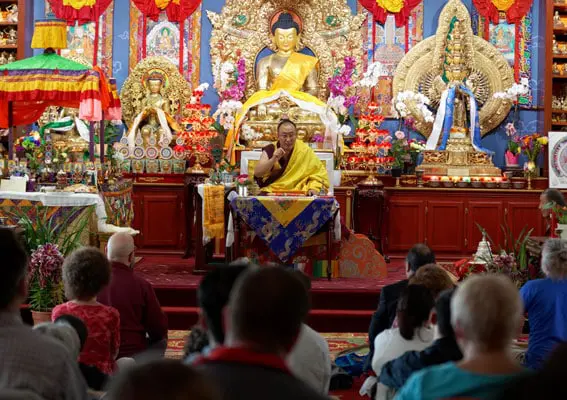
In the summary of 2014, after many years of sustained effort introducing the Kalachakra Dharma to Western students, Rinpoche met a Canadian man named Joe Flumerfelt who soon moved to Melbourne in order to work with Rinpoche. Together, the two focused on expanding the materials Rinpoche had already established in order to fully actualize his vision. As a result of their collaboration, they produced two original books. The first, called “Ocean of Diversity”, expanded upon Rinpoche’s existing rimé book, to include all of the world’s major wisdom traditions and his teachings on how to develop a rimé philosophy. The second, called “Demystifying Shambhala”, expanded upon a small book he had written detailing the history of the Jonang Tradition in Tibet. This book also included Rinpoche’s detailed explanation of the relationship between Shambhala and Kalachakra. In addition to these works, the material presented in “Unveiling Your Sacred Truth” was re-structured and expanded significantly producing a three-volume set.
While these new additions to his collected works were being produced, Rinpoche was invited to give teachings in a variety of cities around the world. In his first world tour, Rinpoche visited many European countries such as Romania, Hungary, Austria, Italy, and Greece. He then continued to the United States where he planted the seeds of Dharma in the American mid-west. The following year, Rinpoche returned to many of these countries in order to continue guiding a growing number of dedicated students. It was also at this time, that Rinpoche began to give a condensed version of the Kalachakra Empowerments as part of his teachings.
By 2017, Rinpoche had successfully laid the groundwork for a global network of Kalachakra practitioners with practice groups started in a handful of cities. Through various large events, Rinpoche was given the opportunity to present many of his new books and also to develop a large number of meaningful Dharma connections with people from all over the world. Since that time, Rinpoche has continued to teach globally, tirelessly introducing people to the teachings of Kalachakra and showing them how to practice.
2018
Manifesting the Golden Age
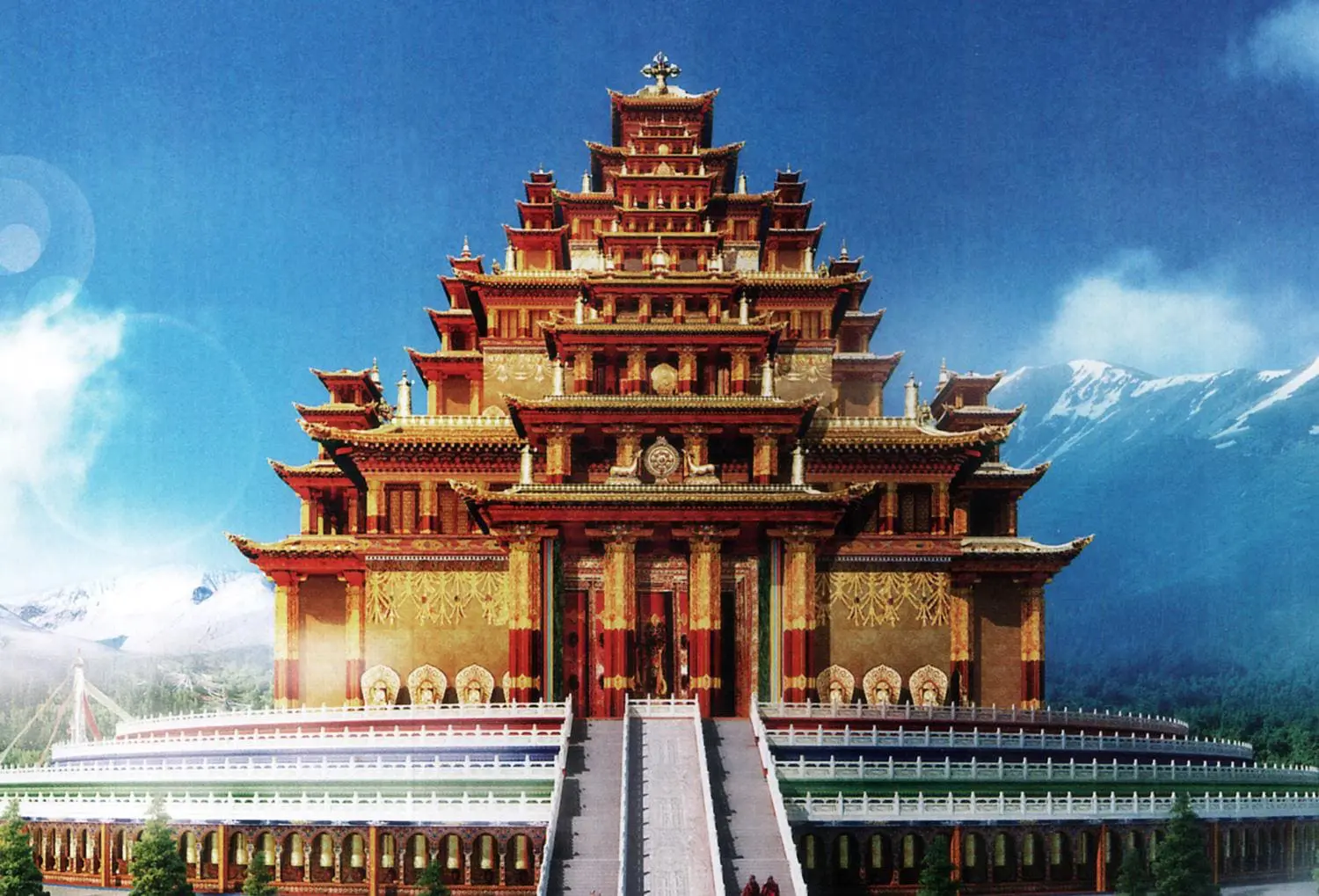
In 2018, Khentrul Rinpoche established Dzokden, an international network of individuals, practice groups, training institutes, and retreat centers. His mission is to generate the causes for global peace and harmony by practicing in accordance with the teachings of the Kalachakra Tantra. While Dzokden embraces the vast diversity of wisdom traditions in this world, it specializes in the profound path of Vajra Yoga—the unique teachings of the Kalachakra completion stage as taught in the Jonang-Shambhala Tradition.
Through Dzokden, Khentrul Rinpoche envisions a world without limitations, a world where each of us has the capacity to discover our infinite potential and where—regardless of the society we belong to or the traditions we follow—individuals can come together as a single global family united in our perfect nature. In such a world free from all forms of bias, our minds will abide in complete peace and harmony, giving rise to a prosperous planet in perfect balance where spirituality flourishes.